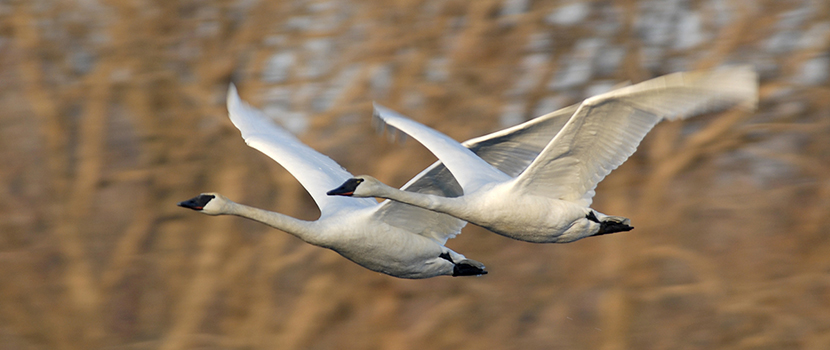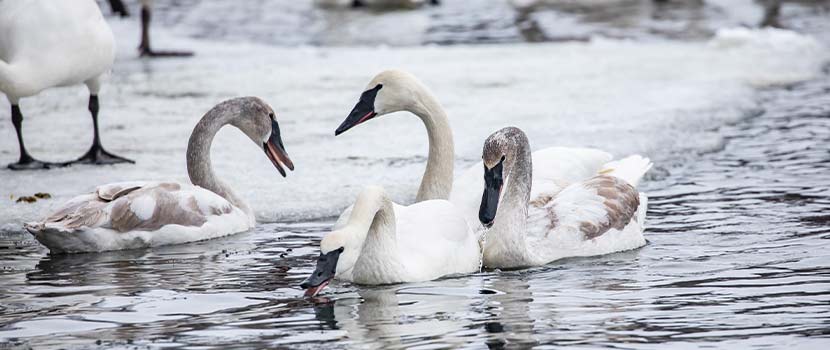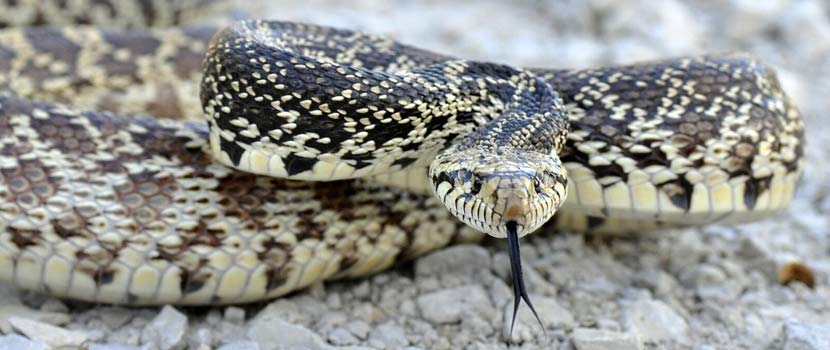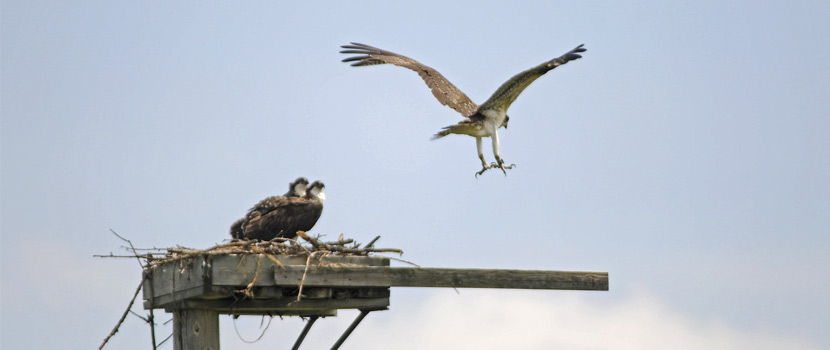Species Reintroduction
Wildlife Management has established programs to help with the reintroduction of native species to the Park District, including Trumpeter Swans, Ospreys, Bullsnakes, and Regal Fritillaries.

Bullsnakes
Three Rivers Park District began a bullsnake reintroduction project at Crow-Hassan Park Reserve in 1991. Eighteen adult snakes were caught at Sherburne National Wildlife Refuge near Princeton, MN and released near the center of the prairie in Crow-Hassan Park Reserve. The snakes were closely followed for several years and monitored though incidental sightings.
In 2013, wildlife staff started a tagging program of the bullsnakes using PIT tags (microchips) to mark individual snakes. In the first three years of marking snakes, 100 adult snakes were tagged. An additional 100 hatchling (baby) snakes were caught, but were too small to tag. Bullsnakes are an important part of the prairie system and should not be disturbed or harassed when encountered in the park. Crow-Hassan Park Reserve is the only park in the system with wild bullsnakes.
Osprey
In 1984, Three Rivers Park District began an Osprey reintroduction project with the goal of returning the species to the metro area as a viable nesting species. Once common in southern Minnesota, these birds had all but disappeared due to loss of habitat, human persecution and use of the pesticide DDT.
The reintroduction began with six young birds from northern Minnesota. They were moved to Carver Park Reserve and released when they were old enough to fly. Osprey learn to hunt and migrate on their own, and that is why this project was a success. From 1984-1995, a total of 144 young birds were added to the Twin Cities population from nine different release sites. Currently there are approximately 100 active nests in the metro area.
In 2014, volunteers started to help monitor the osprey nests in the area. This has been deemed as a huge success from both Three Rivers’ and the volunteers’ perspective. The volunteer program allows citizen scientists to become involved in monitoring and banding of chicks.
Osprey in the Twin Cities - Osprey can be seen at nesting sites from April to August; however, the best time to view them is in late July when the young birds begin to fly. One of the best locations to spot Osprey is Carver Park off of Hwy 11. Several nests are available for viewing from park roads. The Park District also offers public programs that are scheduled each year in July - you can watch chicks receive leg bands.
Osprey choose tall structures to nest and prefer a view of fishable water. Their diet is made up almost entirely of fish, with rare occurrences of osprey taking snakes, frogs and muskrats. Their nesting location needs to be in a tall open area in order to avoid predation from the great-horned owl, their biggest predator.
Regal Fritillaries
Regal Fritillaries are large colorful prairie butterflies that have been declining due to a loss of habitat across the state. The caterpillars of the Regal Fritillary only feed on prairie violets.
In order to make sure there was enough food for the caterpillars, staff at Three Rivers planted 10,000 large prairie violets in selected portions of the Crow-Hassan Park Reserve prairie. In the summer of 2016, staff went to a prairie area south of Wabasha, MN and collected 20 gravid (pregnant) female butterflies. They were released in Crow-Hassan’s prairie close to the violet planting areas. It is hoped that the females will each lay up to 2,000 eggs, and that the caterpillars will start feeding on the violets. The next generation of butterflies will emerge in July and August. At that time the staff will survey the population to see if the reintroduction was successful.
Trumpeter Swans
The Trumpeter Swan reintroduction program at Three Rivers began in 1966 with the release of sub-adult swans. These efforts, combined with similar work by the State of Minnesota Nongame Wildlife Program, have resulted in the establishment of a sustainable population of more than 5,000 trumpeters in Minnesota. The Park District no longer maintains captive swans, but does accept rehabilitated swans that will eventually return to the wild. Spring through fall, you can spot Trumpeter Swans in the following locations:
- Beaver Pond: Parking available on County Road 201. Follow the bike trail to the southeast end of the park. The swans are frequently visible from the horse and bike trails. Round trip about 2 miles.
- Marshview Campground Marsh: Visible from County Road 24 and Marshview Group Camp.
- Lake Katrina: Follow the trail along the lake.
- North Twin Marsh - From the north gate, walk along the gravel road to view North Twin Marsh.
- Mud Lake, Hayden Lake, West Hayden Lake, Powers Lake and Lemans Lake: The swans on Mud and Lemans Lakes are often seen from the bike trails. The other locations are very remote and difficult to view from any trail.
- Fred E. King Waterfowl Sanctuary (Lunsten Lake)
- Rebecca Refuge: Free-flying Trumpeter Swans may be seen here year round. Several hundred swans gather here during late fall. The gravel refuge road can be accessed on foot from the Hilltop picnic area. There is also the John Hannah Trumpeter Swan Overlook that can be reached via the Refuge Trail accessed from the rental/trailhead building.
- Kasma Marsh: Visible from the bike/hike trail on the south side of the park and from the gravel refuge road on the east side. This is the longest continuous Trumpeter Swan nesting site in the Park District.
- Roy Lake and Rattail Lakes also have nesting pairs, but are more difficult to view from the trails.
Related Blog Posts
Reintroducing Trumpeter Swans: What It Took to Succeed
By: John Moriarty
Trumpeter swans once nested throughout Minnesota, but were eliminated by early settlers who hunted them for feathers and food. Learn what it took to restore their populations and explore current efforts in managing trumpeters today.
All About Bullsnakes — And How They Found A Home in Three Rivers
By: John Moriarty
Did you know that the longest snake in Minnesota can be found in Three Rivers Park District? Bullsnake populations have declined in the Twin Cities due to habitat loss, but thanks to reintroduction efforts, they have found a home in Crow-Hassan Park Reserve.
Osprey Reintroduction: The Great Success Story
By: Steven Hogg
Ospreys used to be very common in southern Minnesota, but they disappeared from the Twin Cities after World World II. Learn about the program to bring these amazing birds back and how wildlife can survive in an urban area when given the right tools for success.



